SaaS is one of the fastest growing industries worldwide. IDC predicts that nearly 30% of worldwide enterprise applications will be SaaS based by 2019, generating around $112 billion revenue, up from $48.8 billion in 2014 with featured YoY growth rate of 24.4%. With technology moving forward at such a ridiculously fast pace, SaaS market is forecasted to have nearly six times higher demand by 2019, with a compound annual growth rate of 18.3%, over traditional software market (with CAGR only at 3.1%.)
Just looking at these numbers, it’s clear that SaaS is “the thing you want to be in.” However, popularity and potential doesn’t come without a price: with so many SaaS companies, big and small, offering services that are very similar in terms of the core product, how do you make customers choose your service/product over others? The competition is always fiercest in the industries with the most potential and SaaS is no different. Under these harsh circumstances, differentiation is essential for brand recognition, gaining market share and establishing your feet on the ground firmly, if you want to grab a piece of the pie.
The main mistake
A lot of vendors position themselves as a company that offers comfortable services 24/7, which are easy to use, have an intuitive user interface, exceptional customer service and tons of useful features/functionalities. But then, that’s kinda the same thing that everyone is offering nowadays. In fact, it has come to a point where your product won’t even be considered by consumers if you lack any of the features mentioned above. You can’t surprise anybody with that sort of thing anymore: rather, it’s the lowest threshold of survival in the SaaS industry.
The reality about differentiation
The thing is that companies cannot compete on features anymore, while having the same core service. Even if you add cool functionalities, the vast majority of the consumers will be using your product for the core service and won’t even care about the additional stuff. If you want to survive in your niche, you will need to offer, market and promote something more than additional cool features: you need to find a way to make the life of your consumers easier, by providing newer solutions that would address their needs and wants with the help of your core service.
Great SaaS examples of differentiation
The true differentiation for a SaaS company today, lies in producing innovation or offering something that isn’t being offered by anybody else. This isn’t a completely brand new idea though: there are tons of examples of highly successful SaaS companies that took their niche by storm, while having many other vendors providing similar services at the same time.
Dropbox
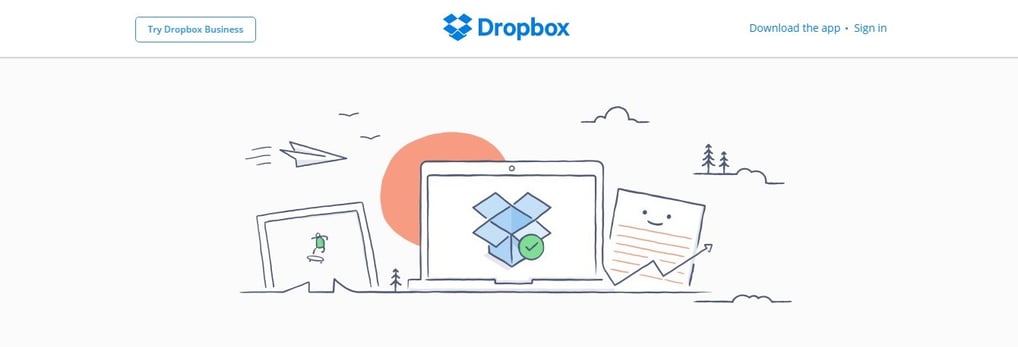 In 2007, one of the biggest dilemmas of internet was to enable file sharing and provide storage that could be accessed from any device, anywhere, as long as there was an internet connection. Some file sharing apps and services already existed, but none of them offered the solution and ability to keep your all files in a single place which could be accessible by any device. The idea for the successful cloud service company offering file hosting, cloud storage, file syncing and client software was conceived in 2007 by MIT student Drew Houston when he was travelling to Boston by a train. Houston was determined to work during the four hour trip, but forgot his flash drive and was stuck with no files at hand and a ton of work to do. Dropbox’s founders basically differentiated themselves by offering what the public was looking for, before they actually realized that they were looking for it. Here is the growth of the number of registered users that happened in five years:
In 2007, one of the biggest dilemmas of internet was to enable file sharing and provide storage that could be accessed from any device, anywhere, as long as there was an internet connection. Some file sharing apps and services already existed, but none of them offered the solution and ability to keep your all files in a single place which could be accessible by any device. The idea for the successful cloud service company offering file hosting, cloud storage, file syncing and client software was conceived in 2007 by MIT student Drew Houston when he was travelling to Boston by a train. Houston was determined to work during the four hour trip, but forgot his flash drive and was stuck with no files at hand and a ton of work to do. Dropbox’s founders basically differentiated themselves by offering what the public was looking for, before they actually realized that they were looking for it. Here is the growth of the number of registered users that happened in five years: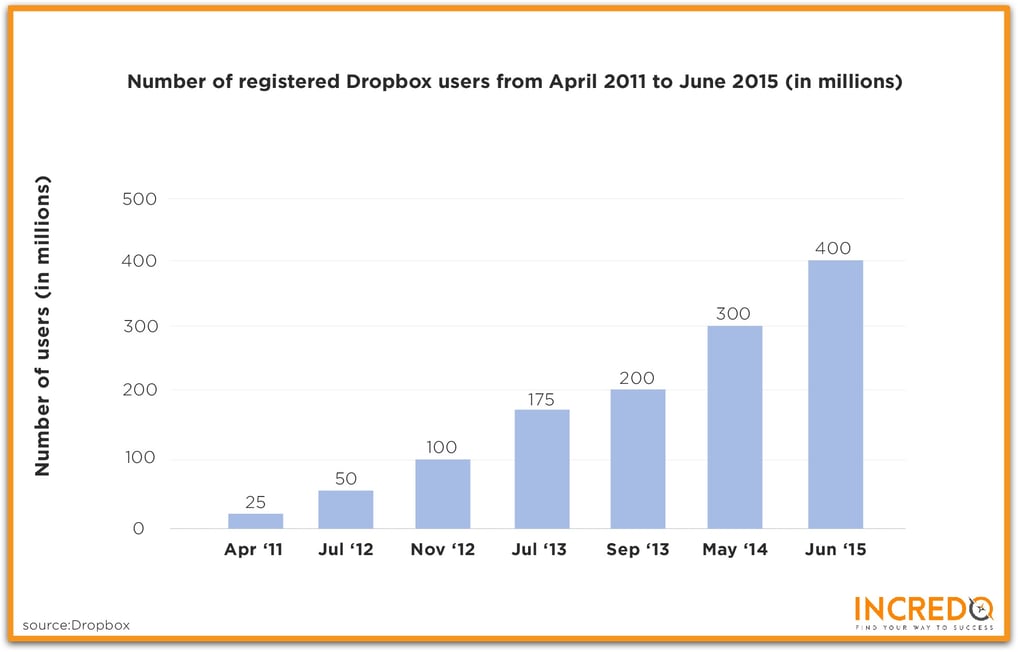 To this day, Dropbox is considered one of the best cloud file sharing services, even with giants like iCloud and Google Drive around.
To this day, Dropbox is considered one of the best cloud file sharing services, even with giants like iCloud and Google Drive around.
HubSpot
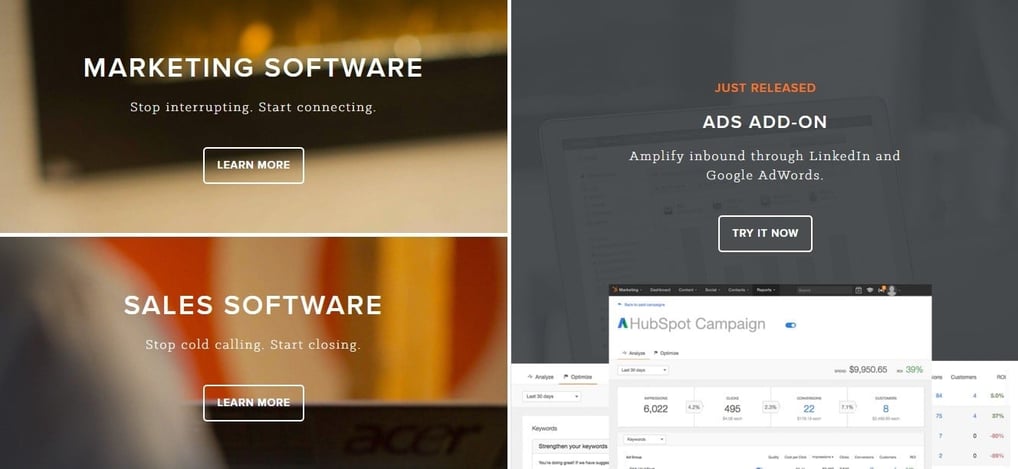 HubSpot, the leader of marketing automation software industry, was founded in 2006. Again, when HubSpot was still an idea for the large market, there were tons of other platforms available (mainly Marketo, which is widely used to this day) that people used for tracking website analytics and automating online marketing. But the problem was that everything concerning website analytics and various marketing activity analytics tools were scattered all over the place. Companies needed to either have marketers that were proficient in IT or maintain a strong IT department to be able to sync, integrate and merge everything together, all while managing to keep track of everything on different platforms. HubSpot offered a solution, which provided the option to have all of your essential website analytics on a single platform that didn’t require any IT knowledge to use and manipulate or understand data. The graph below is a living proof of their excellent differentiation strategy:
HubSpot, the leader of marketing automation software industry, was founded in 2006. Again, when HubSpot was still an idea for the large market, there were tons of other platforms available (mainly Marketo, which is widely used to this day) that people used for tracking website analytics and automating online marketing. But the problem was that everything concerning website analytics and various marketing activity analytics tools were scattered all over the place. Companies needed to either have marketers that were proficient in IT or maintain a strong IT department to be able to sync, integrate and merge everything together, all while managing to keep track of everything on different platforms. HubSpot offered a solution, which provided the option to have all of your essential website analytics on a single platform that didn’t require any IT knowledge to use and manipulate or understand data. The graph below is a living proof of their excellent differentiation strategy:
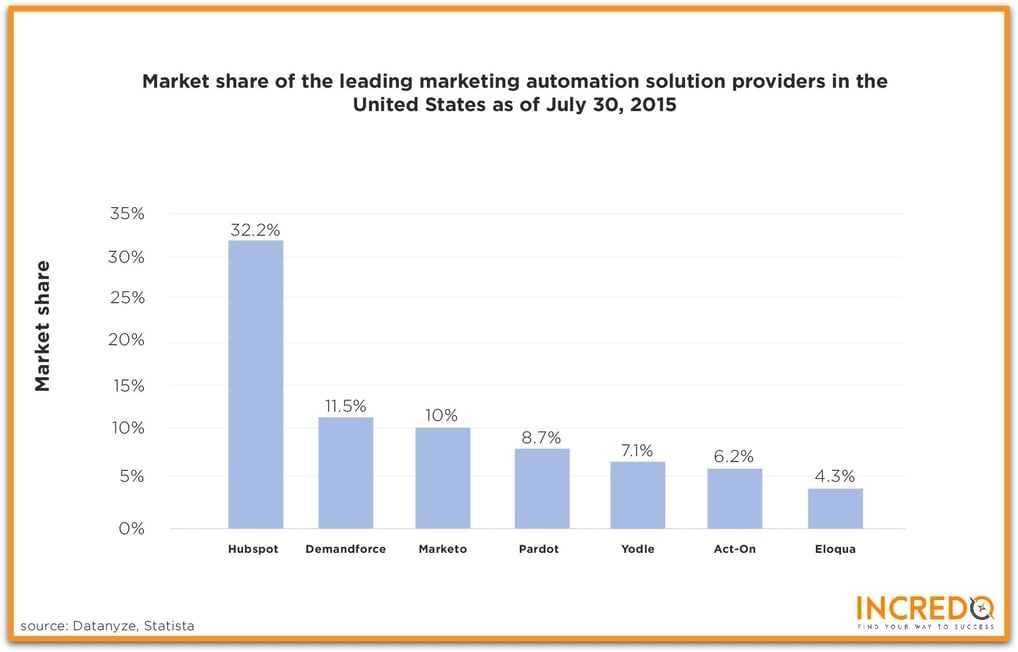 Slack
Slack
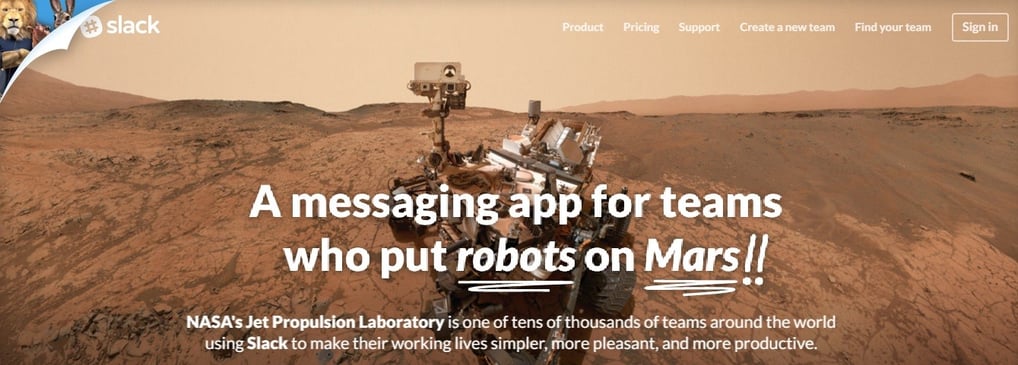 Slack was originally developed by Stewart Butterfield and his team merely for internal usage in their own company, while in the midst of developing another project called Glitch, a nonviolent MMO video game. The developers of the game required tons of communication and collaboration platforms like IRC, Skype, etc. but they just didn’t cut it. Instead, the team got into developing their own platform, which would fit all the needs that their development team had in terms of communication and collaboration. Skype provided the ability to video call and screen share, but that’s it. Tools like Trello allow users to distribute, plan and monitor the execution of different tasks in a project, but lack many useful features and don’t offer screen sharing. Slack basically does it all. It’s a combination of all the tools needed for effective and productive collaboration and communication that any development, marketing or any other team might need. That was their differentiation of the core service. Companies that started using slack reported on average a 40% increase in their overall team productivity and around 70% reduction in using internal emails:
Slack was originally developed by Stewart Butterfield and his team merely for internal usage in their own company, while in the midst of developing another project called Glitch, a nonviolent MMO video game. The developers of the game required tons of communication and collaboration platforms like IRC, Skype, etc. but they just didn’t cut it. Instead, the team got into developing their own platform, which would fit all the needs that their development team had in terms of communication and collaboration. Skype provided the ability to video call and screen share, but that’s it. Tools like Trello allow users to distribute, plan and monitor the execution of different tasks in a project, but lack many useful features and don’t offer screen sharing. Slack basically does it all. It’s a combination of all the tools needed for effective and productive collaboration and communication that any development, marketing or any other team might need. That was their differentiation of the core service. Companies that started using slack reported on average a 40% increase in their overall team productivity and around 70% reduction in using internal emails:
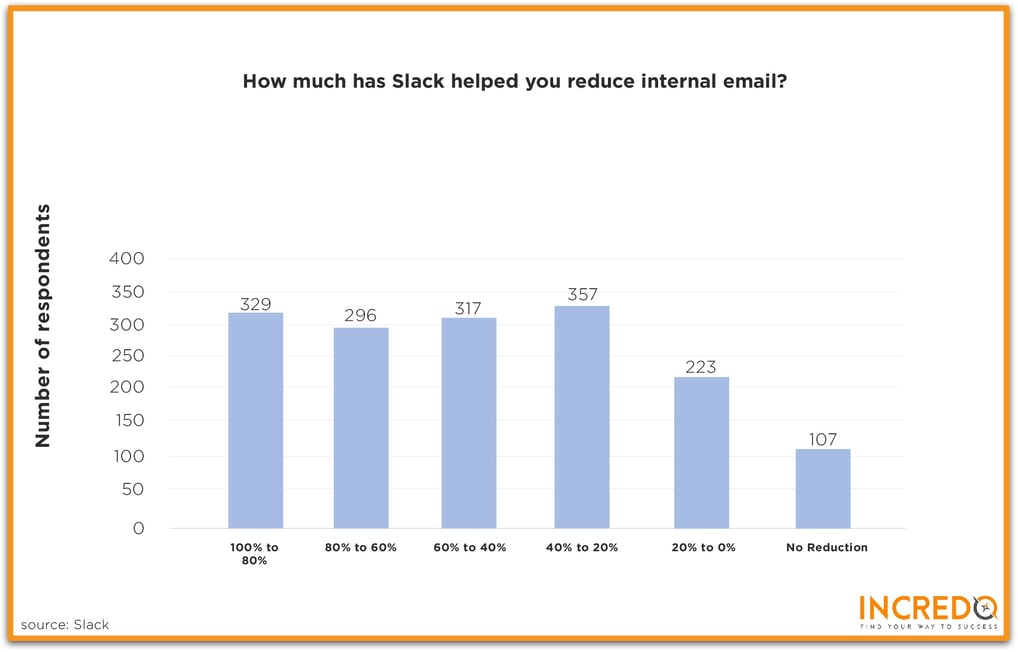 Today, Slack has around 2.7 million users (with 800.000 paying users in the midst), with a weekly active user growth rate of 3-5% and over 100 million hours of monthly usage.When you take a close look at all three examples, you will notice a few similarities:
Today, Slack has around 2.7 million users (with 800.000 paying users in the midst), with a weekly active user growth rate of 3-5% and over 100 million hours of monthly usage.When you take a close look at all three examples, you will notice a few similarities:
1. All the products were developed with the end user in mind
Each example illustrates a clear value that it brings to each user. While each of the three products are somewhat similar to other products that were already present in the market, the core value is different and/or advanced: it’s either a combination of different existing tools or services that didn’t exist before or a brand new way to make people’s lives easier.
2. All the products have a clear value proposition that every user can instantly grasp and understand
The value proposition of each product is so simple; it’s hard to add anything to it. You get a tool that will let you share and access all your files from all devices (Dropbox), a tool that will help track all online activity analytics from the same platform (HubSpot) and a tool that enhances team communication and collaboration with everything you need to succeed (Slack).
3. All of them solve (or at least simplify) complex community problems
All three products solve consumer challenges that consumers didn’t realize they faced yet, presumably the most paramount of the similarities. Consumers are mostly unaware that they need something better than what already exists in the market to solve day to day problems and achieve better results. When you look for a tool online, you get to choose from what’s already available and have no other option but to compromise something in exchange for something else. This is the power of differentiation. It’s not about features, or excellent customer support: it’s about positioning yourself in a way that will and make consumers more productive and effective at what they do. Apart from those, there are a few more aspects to differentiation.
Correct audience segmentation
One of the important keys to differentiation strategies is advanced consumer targeting. If you mistarget your audience, the news will read “X% of consumers abandoned a brand due to receiving poor marketing messages.” That’s heartbreaking to lose customers just because you didn’t know them well enough. Understanding your consumers should be seen as a continuous process, not just a one time venture. Consumer preferences evolve over time and whatever worked a few years ago, might actually hurt your bottom line today. Another important thing to keep in mind is that your research and marketing activities should be data driven. Knowing some general things about your customer and thinking from their perspective for a few minutes isn’t going to cut it: you need to use and leverage every piece of data available to you in order to create personalized, high quality marketing messages that will really leave an impact on your consumers. Recent studies by the American Marketing Association have revealed that the number one marketing challenge of 2016 is reliable data and analytics interpretation. On the bright side, there is a lot of data hidden all over the web that you can use effectively. The research of eMarketer and Venturebeat reveals the best channels for acquiring historical customer data, which is used for creating personalized marketing messages by brands worldwide.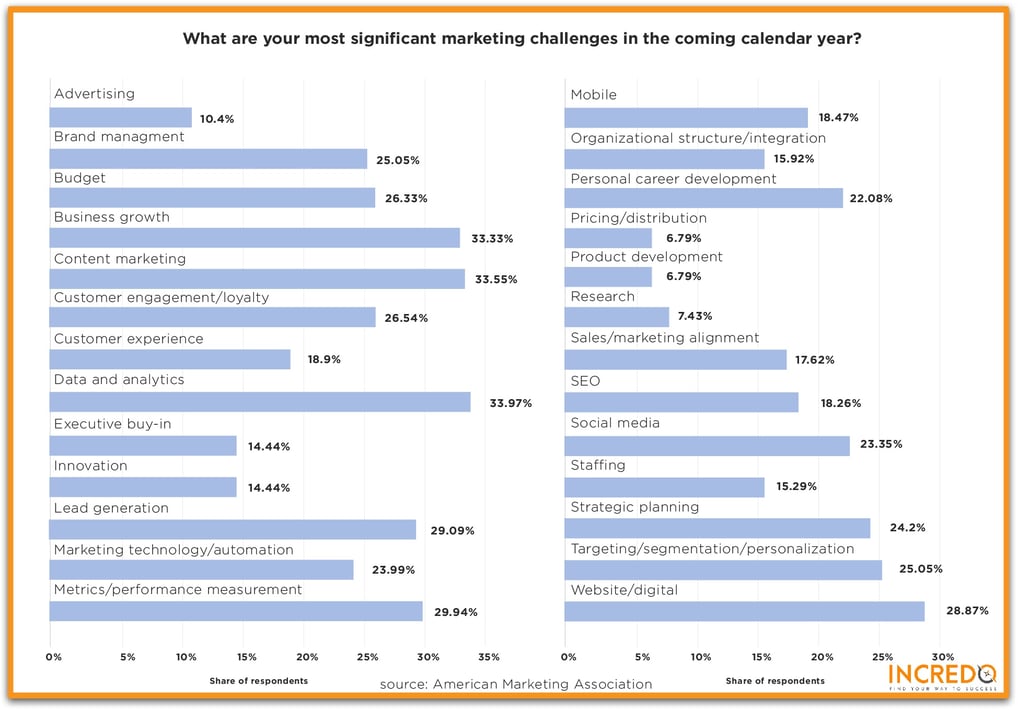 On-site activity, social media activity and search engine activity make the top of the list for customer personalization and there is a good reason why.
On-site activity, social media activity and search engine activity make the top of the list for customer personalization and there is a good reason why.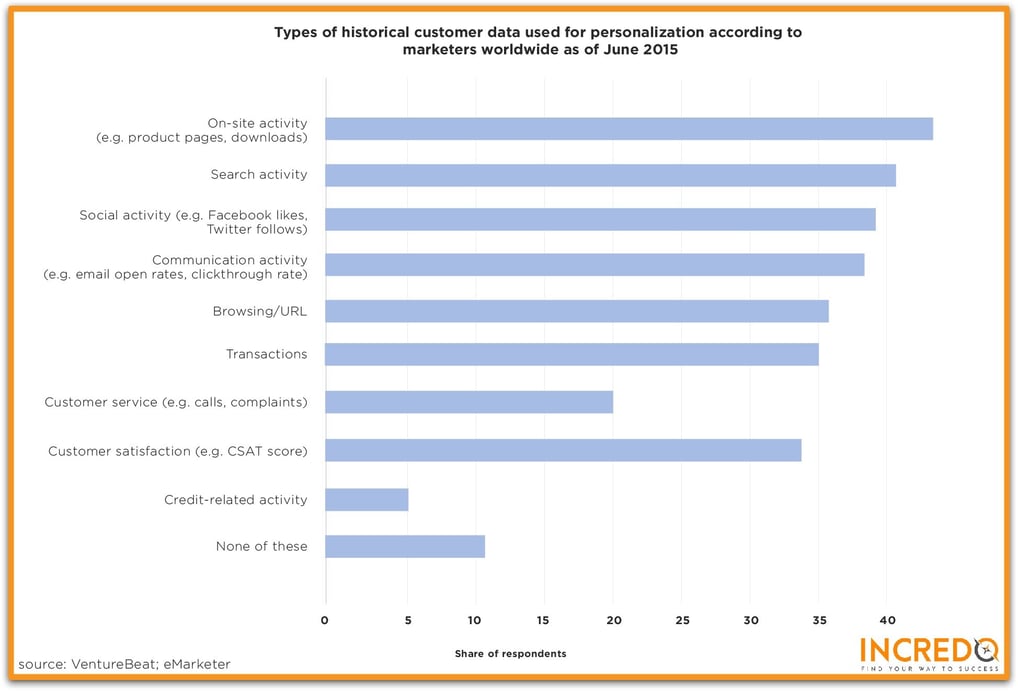 Customers often (indirectly) tell brands what they want to get, hear, see, listen, buy, etc. all over the web. They leave comments, browse, search, post status updates, participate in discussions among other measurable activities, which can give companies a very good idea about their lifestyle, habits and personal preferences. The difficult part is listening carefully and picking up value out of all the “wild talk” that’s going on around 24/7.
Customers often (indirectly) tell brands what they want to get, hear, see, listen, buy, etc. all over the web. They leave comments, browse, search, post status updates, participate in discussions among other measurable activities, which can give companies a very good idea about their lifestyle, habits and personal preferences. The difficult part is listening carefully and picking up value out of all the “wild talk” that’s going on around 24/7.
Social media highlights
Social media is widely used by your consumers every day. Statistics by The power of innovation: why ever (finance) executive team needs to visit Silicon Valley at least once a year Ogilvy and eMarketer show that 69% of people go directly to the brand’s website after they hear about it on social media, and 66% research the brand online. The interesting part is that for research purposes, customers use social media channels as well. The usage of social media channels worldwide across all platforms is relatively the same, with only Instagram being slightly better for consumers’ research purposes.
The interesting part is that for research purposes, customers use social media channels as well. The usage of social media channels worldwide across all platforms is relatively the same, with only Instagram being slightly better for consumers’ research purposes.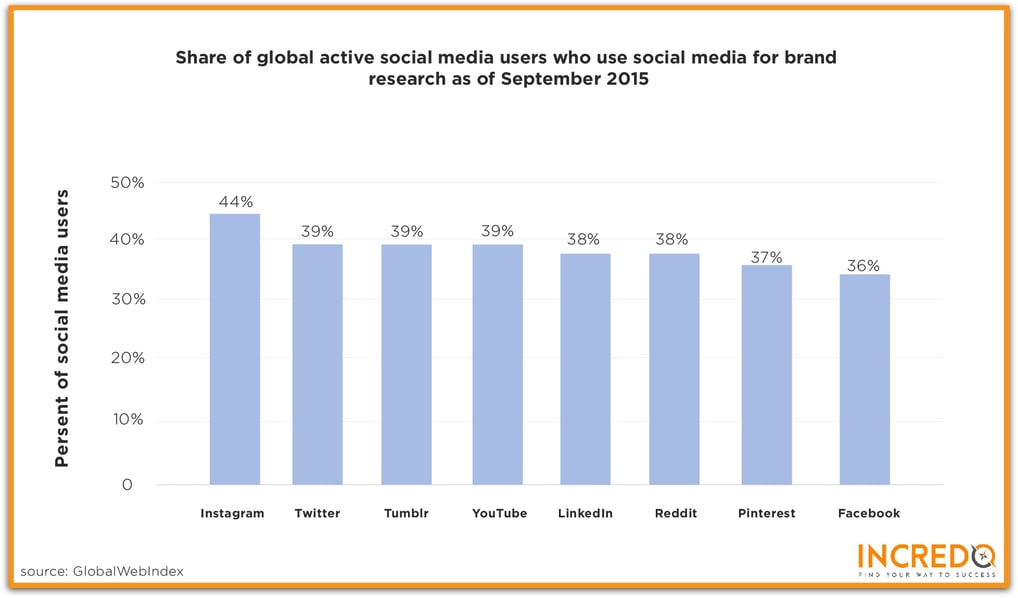 Depending on your social media channel focus and strategy, you are probably using a few of the most popular social media channels listed above. While they are all good sources to gain valuable insight about your consumers (particularly if you take a look at community groups like LinkedIn groups), there is one source of practically endless consumer data that is often overlooked by companies.
Depending on your social media channel focus and strategy, you are probably using a few of the most popular social media channels listed above. While they are all good sources to gain valuable insight about your consumers (particularly if you take a look at community groups like LinkedIn groups), there is one source of practically endless consumer data that is often overlooked by companies.
Quora – your best friend in consumer research
Quora is a social media website where people posts virtually all kinds of various questions and get answers from some of the best professionals in the world around the particular topic. With over 100 million monthly active users, and about half of those being from the U.S. (which means that approximately 350k people from the U.S. use Quora daily), this is a real goldmine for companies. Just pick your topic and scroll through the questions. You will find so much information about what your consumers want and are looking for that you will have a hard time keeping up with the questions and answers. You can also register yourself on the website and answer consumer questions as an industry expert. This will help increase your reach, brand authority and position yourself as a thought leader in your industry.
Keyword research
When you think about “keyword research” likely the only thing that pops in your head is SEO, right? Well, it shouldn’t be. Keyword research isn’t just about driving organic traffic to your website: it’s an essential part of consumer research. Popular keywords give you an idea about what people are searching for, what kind of language they use, with a numerical estimate of how badly are they interested in the topic. Whenever you are trying to interpret data, don’t just go with the obvious route: keep trying to find ways beyond the best practices to extract every benefit from the data at hand. What does this data tell me apart from what I see? This is the question you have to ask yourself constantly.
Blog comments
Exceptional content marketing is one of the driving forces of SaaS businesses. Whenever your content attracts visitors to your blog, you are provided an excellent opportunity to gather consumer habit insights directly from them. To achieve this, encourage users to leave comments at the end of your blog posts. If you already are doing that, awesome. The crucial part that most businesses miss out on though is that you can actually ask consumers to leave comments about the topic you are most interested about. Don’t just ask people to leave a comment, ask them to leave a comment specifically about what you want to know. In this guest post published on Ramit Sethi’s blog, one of the most influential and inspirational entrepreneurs in the world, the author encourages readers to share specific information:  In one of the responses below, a reader mentions another website that he found useful. This is an excellent opportunity to dig deeper and find out why exactly the other website proved to be of use to that reader and extract important information from there.
In one of the responses below, a reader mentions another website that he found useful. This is an excellent opportunity to dig deeper and find out why exactly the other website proved to be of use to that reader and extract important information from there.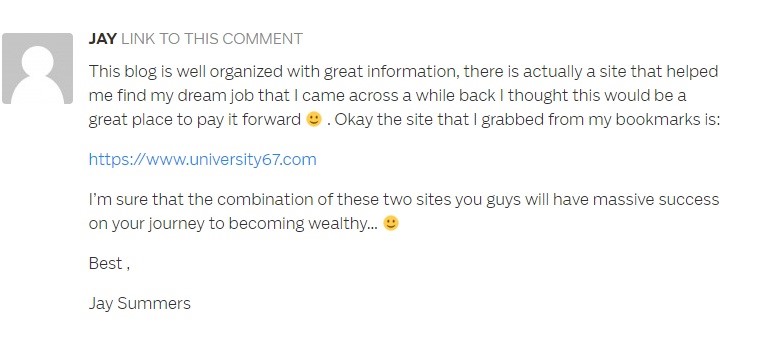 Finally, it’s not only about your own blog. You can use your competitor’s blog for the same purpose, or research around the web to find blogs relevant to your niche and poke around. You will be surprised how much information you will find that you didn’t think about before.
Finally, it’s not only about your own blog. You can use your competitor’s blog for the same purpose, or research around the web to find blogs relevant to your niche and poke around. You will be surprised how much information you will find that you didn’t think about before.
Offer more than customer support
As discussed earlier, premium customer support is something that is expected from all SaaS companies by default. If you aren’t reachable 24/7, can’t solve consumer issues or fail to deliver required help to your consumers, they will be gone in the blink of an eye. In the graph below you will find the major factors for when businesses choose a SaaS CRM company. Customer support only accounts for 8% of respondents, which makes it clear that high quality support isn’t something extraordinary anymore: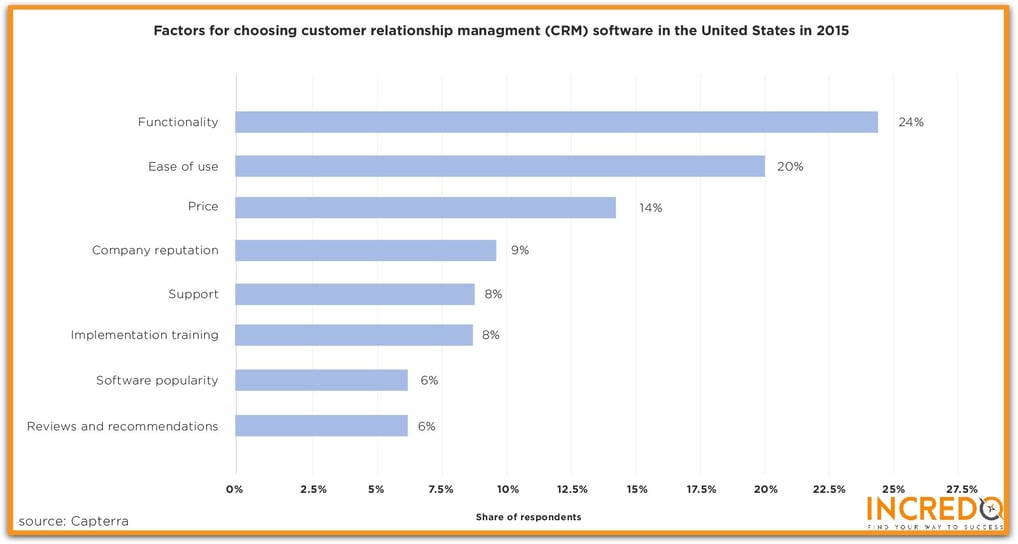 Most companies have already realized the importance of premium customer support, so for differentiation purposes you will need to do more than that. The real question is what can your team offer in addition to customer support? The key to offering godlike support is the ability to predict the challenges that customers are likely to face in the future, and address them before they even come to fruition. A great example here is HubSpot academy and knowledge center. Since the company is actively engaged in inbound marketing techniques, and is considered one of the most influential companies in the industry (HubSpot’s blog receives over 2 million views each month), they do everything in their power to deliver the impossible to their users.
Most companies have already realized the importance of premium customer support, so for differentiation purposes you will need to do more than that. The real question is what can your team offer in addition to customer support? The key to offering godlike support is the ability to predict the challenges that customers are likely to face in the future, and address them before they even come to fruition. A great example here is HubSpot academy and knowledge center. Since the company is actively engaged in inbound marketing techniques, and is considered one of the most influential companies in the industry (HubSpot’s blog receives over 2 million views each month), they do everything in their power to deliver the impossible to their users.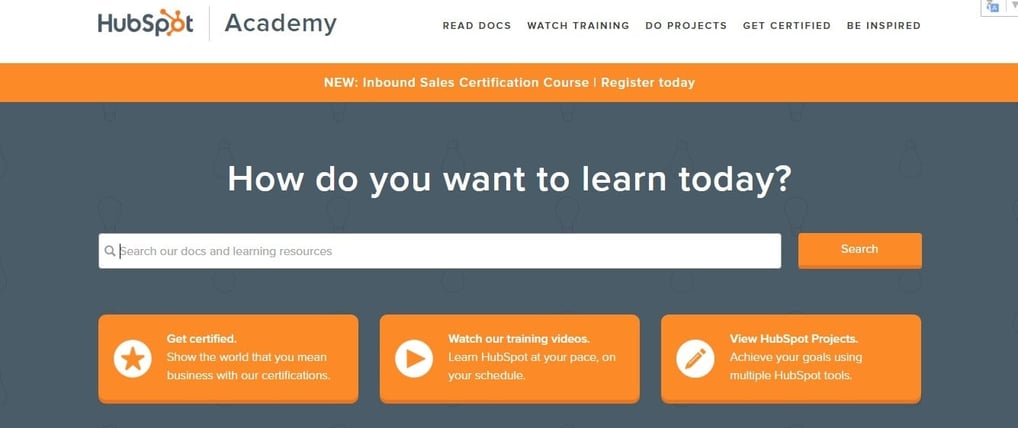 The HubSpot academy offers certifications on a variety of topics including inbound, HubSpot, design and partner certifications, as well as a vault of education materials and videos for improving analytics, building brand authority, increasing visits, conversions and basically every other thing that a digital/inbound company might be interested in. This is what it means to go the extra mile with customer care. Answering emails and phonecalls is great, but to really impress and differentiate yourself, you must always think outside the box.
The HubSpot academy offers certifications on a variety of topics including inbound, HubSpot, design and partner certifications, as well as a vault of education materials and videos for improving analytics, building brand authority, increasing visits, conversions and basically every other thing that a digital/inbound company might be interested in. This is what it means to go the extra mile with customer care. Answering emails and phonecalls is great, but to really impress and differentiate yourself, you must always think outside the box.
Social media customer care and SaaS
Due to the nature of SaaS being cloud-based, your best shot at providing exceptional customer support is via social media. The advantage here is that your customers are most likely using social media channels actively and will be inclined to receive their support through social channels. Social media has a number of advantages over traditional customer support methods:
- It let’s you interact with customers in real-time, the very moment you receive a comment or a complaint, whereas emails and phone calls take more time and are less reliable
- Your actions taken will be seen by millions of others which gives you the option to show how much you care about your customers and improve brand authority
- With so much reach available, you will be able to drive more traffic to your website and gain the trust of potential consumers, just by solving your existing customers’ problems
In this infographic by Kissmetrics, a leading website analytics SaaS company, it’s mentioned that:
- 78% customers believe social media to be the future of customer service
- 46% customers expect brands to provide customer service on facebook
- 88% of customers are less likely to buy from companies that leave social media complaints unanswered
Given the fact that an average person has around 250 friends on Facebook and that an average dissapointed customer shares his bad experience with more than 20 people, your company may lose the reputation you spend years on building up overnight, because of a couple of dissatisfied customers’ comments on social media. Don’t let that happen.
Focus on innovation
One more secret ingredient that brings together all three of the above mentioned examples that we didn’t yet mention is continuous innovation. Even if you did develop something extraordinary, you will have competition spawning out of nowhere within months, even weeks oftentimes. Competition will instantly see the opportunity and try to copy your product in one way or another and improve upon it. This is why you need to constantly innovate and enhance your already existing product, while preserving the core service value. An example of a company failing to innovate and thus, losing relevance during the past few years is Skype. Skype has been around and dominated the video call/sharing (and later mobile messaging) market since 2003, but is now rapidly losing market share to other, similar messaging apps (WhatsApp mainly, which is now the most popular messaging app worldwide) that technically do the same thing, with a couple of additions. Probably the only significant difference between WhatsApp and Skype is that Whatsapp enables people to send SMS/text messages to phone contacts, without charging any money. Let’s face it, this isn’t the most wild feature for a messaging app and Skype could have easily come up with a similar solution years ago. What’s even worse though, after witnessing the increasing popularity of WhatsApp (largely due to the SMS feature), Skype still did nothing to catch up to the new, and now matured, competitor. According to GlobalWebIndex, Skype accounts only for 19% active usage of mobile messaging apps with Facebook Messenger and WhatsApp dominating the market (36% and 34% accordingly).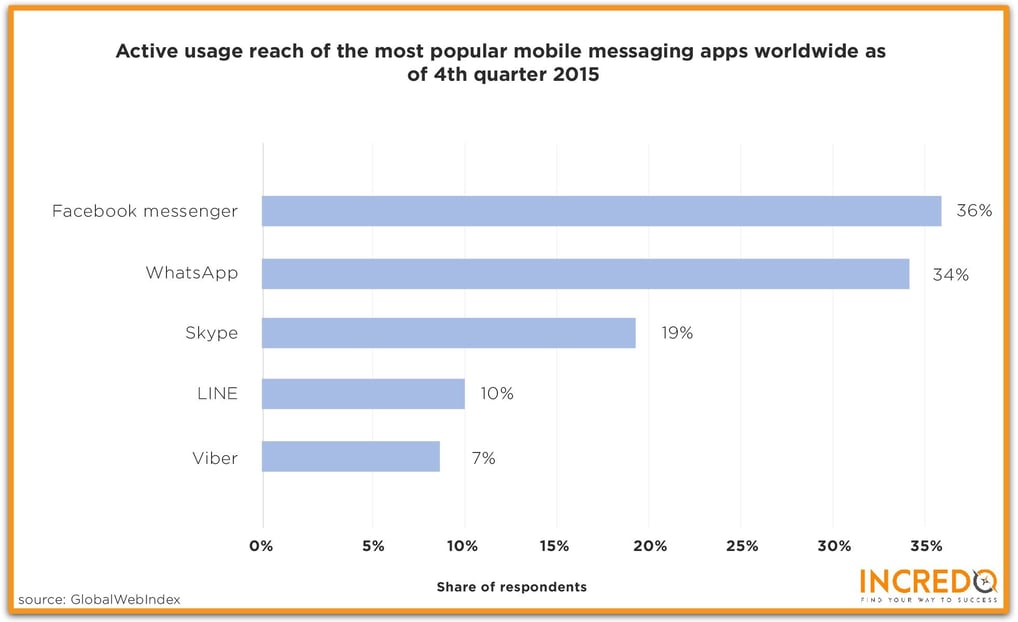 Skype was technically the founding father of online video communication (and later messaging app communication), which is now slowly exiting the spotlight, simply due to lack of innovation and R&D. Skype’s downfall shows exactly why it’s important to continuously innovate, even if you have the first-mover advantage. If we go back to the three examples above, each of those companies are working their butts off to constantly innovate and deliver better a user experience for their customers (and thus, differentiate themselves from others). For instance, Dropbox is reinforcing its product with security options and additional features to strengthen the core value of the product – information sharing. HubSpot is constantly searching for new ways to make it even easier and more efficient to track analytics for marketers. Slack made its product so convenient to use for communication purposes that people took it out of business and started using it in their homes. This was the first time in history since Microsoft office, as mentioned by Financial Times, that office software migrated into the household. In conclusion, it’s safe to say that true differentiation is evolution. Technology, consumers, their preferences and buying habits evolve constantly, and as time goes by the pace increases quicker and quicker. If you want to keep up and stay on top of your game as a SaaS business you need to always be one step ahead: competitors, customers and the challenges for both. This is the true formula to SaaS success today. Do you use any other differentiation strategies that produce results? Share them with us, we can’t wait to see them!
Skype was technically the founding father of online video communication (and later messaging app communication), which is now slowly exiting the spotlight, simply due to lack of innovation and R&D. Skype’s downfall shows exactly why it’s important to continuously innovate, even if you have the first-mover advantage. If we go back to the three examples above, each of those companies are working their butts off to constantly innovate and deliver better a user experience for their customers (and thus, differentiate themselves from others). For instance, Dropbox is reinforcing its product with security options and additional features to strengthen the core value of the product – information sharing. HubSpot is constantly searching for new ways to make it even easier and more efficient to track analytics for marketers. Slack made its product so convenient to use for communication purposes that people took it out of business and started using it in their homes. This was the first time in history since Microsoft office, as mentioned by Financial Times, that office software migrated into the household. In conclusion, it’s safe to say that true differentiation is evolution. Technology, consumers, their preferences and buying habits evolve constantly, and as time goes by the pace increases quicker and quicker. If you want to keep up and stay on top of your game as a SaaS business you need to always be one step ahead: competitors, customers and the challenges for both. This is the true formula to SaaS success today. Do you use any other differentiation strategies that produce results? Share them with us, we can’t wait to see them!
Tags:
SaaS Growth
August 4, 2016



Comments